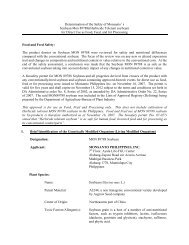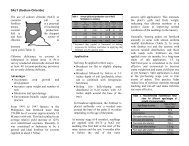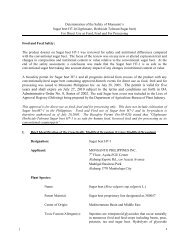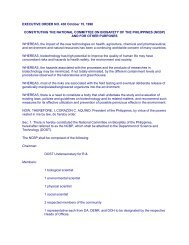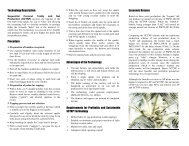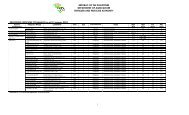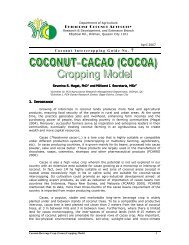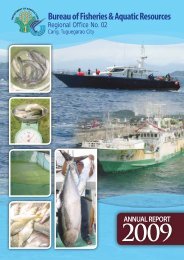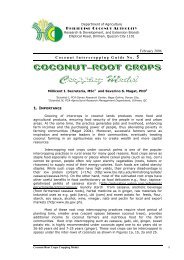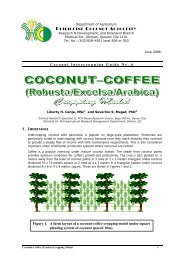Crop Nutrition Management in the Philippines, Salient efforts and ...
Crop Nutrition Management in the Philippines, Salient efforts and ...
Crop Nutrition Management in the Philippines, Salient efforts and ...
You also want an ePaper? Increase the reach of your titles
YUMPU automatically turns print PDFs into web optimized ePapers that Google loves.
DEVELOPMENT OF COCONUT CROP NUTRITIONMANAGEMENT IN THE PHILIPPINES: SEQUENCE OFSALIENT EFFORTS AND MILESTONES (1975 – 2008)Sever<strong>in</strong>o S. Magat, PhDDepartment Manager III <strong>and</strong> Scientist IVPhilipp<strong>in</strong>e Coconut Authority/Department of AgricultureElliptical Rd., Diliman, Quezon City 1101 Email: sev_magat@yahoo.com__________________________________________________INTRODUCTIONAn organized <strong>and</strong> coord<strong>in</strong>ated coconut R & D of <strong>the</strong> country had been operat<strong>in</strong>g foralready 41 years (1967 – 2008) to date. Because of <strong>the</strong> dynamics of <strong>the</strong> environment orecosystems, <strong>and</strong> <strong>the</strong> advances <strong>and</strong> <strong>in</strong>troduction of genetic or plant<strong>in</strong>g materials <strong>in</strong>coconut agriculture, <strong>the</strong> search for effective <strong>and</strong> efficient crop nutrition <strong>and</strong> fertilizationfor productive, profitable <strong>and</strong> susta<strong>in</strong>able farm<strong>in</strong>g is cont<strong>in</strong>ually pursued <strong>in</strong> <strong>the</strong>Philipp<strong>in</strong>es from <strong>the</strong> period of <strong>the</strong> Philipp<strong>in</strong>e Coconut Research Institute (PHILCORIN)<strong>and</strong> FAO/UNDP Cooperation Research Program to <strong>the</strong> current President GloriaMacapagal-Arroyo government adm<strong>in</strong>istration era. This important coconut <strong>in</strong>dustrydevelopment scientific <strong>and</strong> technological support is largely led by <strong>the</strong> PCA,particularly, through <strong>the</strong> <strong>Crop</strong> Agronomy, <strong>Nutrition</strong> <strong>and</strong> Farm<strong>in</strong>g Systems Program(CANFARMS) of <strong>the</strong> Research <strong>and</strong> Development, <strong>and</strong> Extension Branch (PCA-RDEB).The CANFARMS RDE program is technically based at <strong>the</strong> Davao Research Center(Bago-Oshiro, Davao City, Sou<strong>the</strong>rn M<strong>in</strong>danao) <strong>and</strong> supports <strong>the</strong> o<strong>the</strong>r R&D programs.Over a long period, due to our <strong>in</strong>ability to access, review <strong>and</strong> harness outputs <strong>in</strong>scientific <strong>and</strong> technological <strong>in</strong>itiatives <strong>and</strong> endeavors by public <strong>and</strong> private agencies, itis not surpris<strong>in</strong>g to f<strong>in</strong>d that many do not know <strong>the</strong> significant f<strong>in</strong>d<strong>in</strong>gs of <strong>the</strong> governmentcoconut <strong>in</strong>dustry authority (PCA) <strong>in</strong> <strong>the</strong> country on crop nutrition <strong>and</strong> fertilizationmanagement, hence <strong>the</strong> need to provide an updated <strong>in</strong>formation, educational <strong>and</strong>communication document (IECD) for <strong>the</strong> benefit of all <strong>in</strong>volved <strong>in</strong> coconut farm<strong>in</strong>g,extension service, research, project plann<strong>in</strong>g, development program <strong>and</strong> policy <strong>and</strong>decision-mak<strong>in</strong>g.In <strong>the</strong> follow<strong>in</strong>g sections is <strong>the</strong> chronological order (sequence) of significant orrelevant <strong>in</strong>itiatives <strong>and</strong> f<strong>in</strong>d<strong>in</strong>gs by <strong>the</strong> Authority. Most of <strong>the</strong>se had served extensivelyas a relevant basis or reference on coconut <strong>in</strong>dustry concerns deal<strong>in</strong>g with ------objective development <strong>and</strong> extension directions <strong>and</strong> programs, <strong>and</strong> policies, <strong>in</strong>clud<strong>in</strong>gtechnical <strong>and</strong> site-specific advisories <strong>and</strong> recommendations on management of fragilecoconut soils, agro-ecosystems, cropp<strong>in</strong>g systems, <strong>and</strong> balanced crop nutrients forcoconut farm<strong>in</strong>g <strong>and</strong> coconut-based farm<strong>in</strong>g systems (CBFS), through <strong>the</strong> PCA-RDEBservices to <strong>the</strong> coconut <strong>in</strong>dustry over <strong>the</strong> past <strong>and</strong> ensu<strong>in</strong>g years.- 1 -
THE SCIENTIFIC AND TECHNOLOGICAL INITIATIVES AND FINDINGS1) 1975 – low yields of coconut <strong>in</strong> <strong>in</strong>l<strong>and</strong> areas of <strong>the</strong> country improved by correct<strong>in</strong>g<strong>the</strong> strong or severe Cl deficiency by KCl application, confirm<strong>in</strong>g leaf Cl is l<strong>in</strong>ked withyield (a quadratic response with nut yield <strong>and</strong> a l<strong>in</strong>ear one with copra weight/nut <strong>and</strong>copra per tree; copra weight/nut can be <strong>in</strong>creased by 15-25%, hence not ma<strong>in</strong>lygenetics of coconut but <strong>the</strong> positive <strong>in</strong>teraction of Cl nutrition <strong>and</strong> genetic factor of <strong>the</strong>coconut./ (Magat, Cadigal <strong>and</strong> Habana 1975).2) 1977 - Common salt or sodium chloride (NaCl, 55% Cl) as an effective <strong>and</strong>cheaper fertilizer <strong>and</strong> for <strong>the</strong> control of leaf spot fungus disease of coconut seedl<strong>in</strong>gs/(Magat, Margate <strong>and</strong> Prudente 1977).3) 1978 - The usefulness of foliar diagnosis (leaf analysis) <strong>in</strong> <strong>the</strong> conduct of fieldfertilizer trials (1975-1978) to demonstrate yield improvement <strong>and</strong> profitability byapply<strong>in</strong>g comb<strong>in</strong>ations of s<strong>in</strong>gly fertilizers supply<strong>in</strong>g <strong>the</strong> identified deficient nutrientsunder different sites; reported for <strong>the</strong> first time <strong>in</strong> an International Colloquium on <strong>Crop</strong><strong>Nutrition</strong> <strong>and</strong> Fertilizer Usage ,Auckl<strong>and</strong>, New Zeal<strong>and</strong>/ (Magat 1978).4) 1979 - Significance of leaf analysis <strong>and</strong> network of field fertilizer trials (FFTs) as areliable tool <strong>in</strong> <strong>in</strong>creas<strong>in</strong>g productivity of nutrient-deficient coconut areas <strong>in</strong> <strong>the</strong>Philipp<strong>in</strong>es was confirmed by <strong>the</strong> French Scientists through <strong>the</strong> FAO TechnicalWork<strong>in</strong>g Session on Coconut Production, Manila, December 1979 /(Magat 1979).5) 1981 - Inl<strong>and</strong> coconuts suffer<strong>in</strong>g from mult<strong>in</strong>utrient deficiencies of N, Cl <strong>and</strong> Seconomically corrected with <strong>the</strong> application per tree of: 1.8 kg NH 4 SO 4 + 1.8 kg NaClor 1.8 kg NH 4 SO 4 + 2 kg KCl/ (Magat, Maravilla <strong>and</strong> Padrones 1981).6) 1981- The nationwide leaf survey (1978 – 1980) revealed widespread deficiencies<strong>in</strong> N, Cl <strong>and</strong> S of <strong>the</strong> exist<strong>in</strong>g st<strong>and</strong>s of tall coconuts (2.7 M ha); grouped <strong>in</strong>to 10dist<strong>in</strong>ct deficiency classes <strong>in</strong> a generalized map, with K, P, <strong>and</strong> Mg <strong>in</strong> some areas/(Magat, Habana, Escoton, Labarcon <strong>and</strong> Froilan 1981).7) 1980 to 1985 - A PhD Scholarship for S.S. Magat under <strong>the</strong> Colombo PlanBilateral Agreement (New Zeal<strong>and</strong> <strong>and</strong> Philipp<strong>in</strong>es) centered to <strong>in</strong>vestigate <strong>the</strong>mechanism of <strong>the</strong> relationship/l<strong>in</strong>k of crop growth <strong>and</strong> yield with Cl, K <strong>and</strong> Nanutrition. External Exam<strong>in</strong>ers of his PhD Research, Drs. Peter Draycott (UK) <strong>and</strong>Richard Mart<strong>in</strong> (New Zeal<strong>and</strong>), both recognized <strong>the</strong> orig<strong>in</strong>ality <strong>and</strong> significantcontribution of <strong>the</strong> Magat f<strong>in</strong>d<strong>in</strong>gs to global science, <strong>and</strong> <strong>the</strong>y strongly recommendedto exert <strong>efforts</strong> to published important aspects of his work on Beta vulgaris ( threepublished works with his Academic Supervisor, Prof/Dr K.M. Goh, L<strong>in</strong>coln College,Univ. of Canterbury);8) 1988- Long-term common salt (NaCl experiment) on coconut confirmed <strong>the</strong><strong>in</strong>creased <strong>in</strong> copra weight/nut <strong>and</strong> copra yield, with leaf-N as ma<strong>in</strong> determ<strong>in</strong>ant of nut- 2 -
yield, <strong>and</strong> leaf-Cl of copra (nut or copra/tree), us<strong>in</strong>g annual NaCl rates: 0.88, 1.76,3.52 <strong>and</strong> 7.04 kg/tree /(Magat, Margate <strong>and</strong> Habana 1988).9) 1988 - An estimate of <strong>the</strong> critical <strong>and</strong> optimum level of leaf-S of bear<strong>in</strong>g palmsfound: 0.12% <strong>and</strong> 0.19% (leaf rank 14), respectively /(Magat, Alforja <strong>and</strong> Margate1988).10) 1988 – For <strong>the</strong> first time, an estimate of <strong>the</strong> critical level <strong>and</strong> optimum levels ofcoconut leaf-Cl found to vary with yield <strong>in</strong>dices, as: leaf 14 critical level (both nuts<strong>and</strong> copra) – 0.30% Cl; optimum level: optimum level: nuts/tree – 0.50% Cl ;copra/nut – 0.55% Cl <strong>and</strong> copra/tree – 0.63% Cl /(Magat, Alforja <strong>and</strong> Oguis 1988).11) 1989 – The critical leaf-K confirmed <strong>and</strong> optimum leaf-K determ<strong>in</strong>ed (leaf rank14) for bear<strong>in</strong>g palms identified: 0.80% (nut yield); 1.0% (copra/nut); <strong>and</strong> 0.90%(copra yield/tree) /(Magat <strong>and</strong> Padrones 1989).12) 1990 – The requirement for nutrient chlor<strong>in</strong>e (Cl - ) of coconut at differentdevelopment stages (from nursery to full-bear<strong>in</strong>g stage) presented for <strong>the</strong> first timebased on <strong>the</strong> 15-years (1974 -1988) of PCA field research at <strong>the</strong> Davao ResearchCenter /(Magat <strong>and</strong> Margate 1990).13) 1992 – The positive residual effects of NaCl fertilizer on yield <strong>and</strong> leaf nutrient ofcoonuts revealed, <strong>in</strong>dicat<strong>in</strong>g adequate leaf-Cl <strong>and</strong> stable yields with<strong>in</strong> three yearsafter <strong>the</strong> 3-5 years of regular annual fertilizer application /(Magat, Habana <strong>and</strong>Alforja 1992).14) 1993 – a) Three chloride sources (KCl, NaCl <strong>and</strong> NH 4 Cl) showed similar positiveresidual effects when applied at 0.80 kg Cl/tree per year for 5-6 years; high yieldsma<strong>in</strong>ta<strong>in</strong>ed by palms at leaf Cl of 0.50 – 0.60%, even with zero fertilization <strong>in</strong> <strong>the</strong> nextthree successive years /(Magat, Padrones, <strong>and</strong> Alforja 1993).- b)Ten years after <strong>the</strong> first nationwide yield-limit<strong>in</strong>g factors (leaf nutritionaldiagnosis) survey, six (6) classes of nutrient deficiency was identified <strong>in</strong> 60 prov<strong>in</strong>cescovered, as follows: 1) N-K-Cl-S (4 prov<strong>in</strong>ces); 2) N-K-Cl-S-B (10 prov<strong>in</strong>ces); 3) N-K-Mg-Cl-S (2 prov<strong>in</strong>ces); 4) N-P-K-Cl-S (7 prov<strong>in</strong>ces); 5) N-P-K-Cl-S-B (34 prov<strong>in</strong>ces;<strong>and</strong> 6) N-K-P-Mg-Cl-S-B (3 prov<strong>in</strong>ces)/ (Magat et al 1993)15) 1995- Us<strong>in</strong>g foliar diagnosis (leaf analysis), <strong>the</strong> effectiveness of s<strong>in</strong>gle fertilizerssupply<strong>in</strong>g N, S, <strong>and</strong> Cl <strong>and</strong> Mg as NH 4 S0 4 , KCl, NaCl <strong>and</strong> dolomitic limestone asapplied <strong>in</strong> <strong>the</strong> rehabilitation of <strong>the</strong> World Bank-assisted SCFDP farms cover<strong>in</strong>g atleast 350,000 ha nationwide, showed results of 79 sample farms nationwide with anaverage <strong>in</strong>crease up by: (1) 160% <strong>in</strong> nut yield , 220% <strong>in</strong> copra terms, <strong>and</strong> 240% <strong>in</strong>net <strong>in</strong>comes after 3-4 annual fertilizer applications, from benchmark annual yield dataof 35 nuts/tree <strong>and</strong> 0.94 tons copra/ha /(Magat 1995).16) 1997 – Highly effective manures as that from goat <strong>and</strong> chicken manure comb<strong>in</strong>edwith a Cl-supply<strong>in</strong>g fertilizer (KCl or NaCl) improved vegetative growth, early- 3 -
flower<strong>in</strong>g, <strong>in</strong>creased yield <strong>and</strong> improved drought-resistance of coconut palms(Secretaria <strong>and</strong> Maravilla, 1997).17) 2001 – a) Boron micronutrient application (30-50 g borax/sodiumtetraborate/octaborate per palm) once every 2 years applied to <strong>the</strong> soil on young(1-4) hybrid palms is necessary to prevent abnormal leaf development (i.e.,shortened petioles with almost no leaflets emitted, stick toge<strong>the</strong>r or unseparatedlike a h<strong>and</strong> fan (Magat <strong>and</strong> Cruz 2001).- b) Application of cocopeat plus recommended <strong>in</strong>organic N+K+Clfertilizers significantly <strong>in</strong>creased nut <strong>and</strong> copra yields start<strong>in</strong>g at 3 yr from <strong>in</strong>itialapplications; <strong>in</strong>creases drought resistance of palms (cocopeat holds 8 -10 timeswater) <strong>and</strong> provides 300% - 450% ROI (Magat et al 2001).18) 2003 - a) In <strong>the</strong> country, <strong>in</strong>itiated by SS Magat at <strong>the</strong> PCA’s DavaoResearch Center, a 10-year search (1993-2003) for coconut-specific fertilizercompound with balanced multi-nutrients (N, P, K, Cl, S <strong>and</strong> B) revealed that <strong>the</strong>Magat formulated 14-5-20-0.02 (B), with adequate contents of Cl, S <strong>and</strong> Ca wasfound effective <strong>and</strong> cost-efficient for coconut at even lower rates of only 1-2 kg offertilizer/tree per year, under a coconut-fruit crop (Lanzones) cropp<strong>in</strong>g system. At<strong>the</strong> same time, this fertilizer grade for coconut is applied also to <strong>the</strong> fruit cropwhich requires high levels of leaf Cl (0.25%) like lanzones ( Lansium domesticumCorr.) fruit tree crop. Even at moderate rates of <strong>the</strong> 14-5-20-0.02 (B) was found tobe effective <strong>and</strong> economic for <strong>the</strong> fruit crop. In August 2004, <strong>the</strong> said fertilizergrade started to become available to farmers <strong>and</strong> growers as was launched by amajor fertilizer company <strong>in</strong> <strong>the</strong> Philipp<strong>in</strong>es.- b) Based on a review of <strong>the</strong> data on leaf nutrient levels of three (3) bear<strong>in</strong>gdwarf varieties (Malayan yellow dwarfs, Catigan green dwarfs <strong>and</strong> Tacunan greendwarfs grown at <strong>the</strong> <strong>in</strong>termediate grow<strong>in</strong>g zone of <strong>the</strong> PCA-Zamboanga ResearchCenter (Western M<strong>in</strong>danao, Philipp<strong>in</strong>es), <strong>the</strong> physiological leaf nutrient criticallevels were estimated. Us<strong>in</strong>g <strong>the</strong> average or considered normal values of <strong>the</strong>historical data (4 years), an <strong>in</strong>itial general reference guide for critical nutrientlevels (leaf #14, dry matter): 1.70% N, 0.125%; 0.90% K; 0.38% Ca; 0.26% Mg;0.12% Na; 0.37% Cl; 0.15% S <strong>and</strong> 11 ppm B. (Magat 2003).19) 2004 – a) Bio-organic fertilizer (BOF) can be processed/produced us<strong>in</strong>gorganic materials from plant residues (coir dust, baggasse mudpress, rice straw)<strong>and</strong> animal manures (chicken, sw<strong>in</strong>e, cattle, goat manures) with microbial<strong>in</strong>oculant e.g. Trichoderma harzianum. Compost<strong>in</strong>g <strong>in</strong> 3-4 wks compared to 3months without <strong>in</strong>oculant (Eroy 2004)- b) The variability of <strong>the</strong> nutrient contents <strong>and</strong> chemical properties of coirdust or cocopeat drived from coconut husk <strong>in</strong> different locations was noted. Coirdust is a fair supplementary source of N, P, K, <strong>and</strong> Cl, <strong>in</strong>clud<strong>in</strong>g micronutrients(B, Cu, Fe, Zn, Mn). The acidity ranges from pH 5.2 -7.0; <strong>and</strong> EC 0.10 -1.67ms/cm based from: fresh ( 1 month), 3-5 months, <strong>and</strong> 1 year, under open-fieldpil<strong>in</strong>g storage). Higher contents of K, Cl, <strong>and</strong> Fe of coir dust under coastal areas- 4 -
noted; but, contents of N, P, Ca, ca,Mg, S. B, Zn, Mn <strong>and</strong> Cu were found similar<strong>in</strong> coastal <strong>and</strong> <strong>in</strong>l<strong>and</strong> areas. Under ra<strong>in</strong>fall <strong>in</strong> open-field pil<strong>in</strong>g, Cl content droppedto < 0.25% at 3-5 months <strong>and</strong>
- b) An <strong>in</strong>tegrated crop management (ICM) of coconut hybrid (Catig<strong>and</strong>warf Laguna Tall), with emphasis on N <strong>and</strong> Cl nutrient application, <strong>and</strong>coconut beetle pest management (IPM) was studied at <strong>the</strong> PCA-DavaoResearch Center, Bago-Ohiro, Davao City. Three levels of N (as urea,46% N) <strong>and</strong> chloride (common salt, sodium chloride with 55% Cl) <strong>and</strong> IPMon <strong>the</strong> coconut pest were used <strong>and</strong> observed <strong>in</strong> 2000-2004 early growthperiod.Application of 0.40 – 1.5 kg NaCl/tree/yr dur<strong>in</strong>g <strong>the</strong> first 4 years showedsignificant effects on stem girth, leaf production rate <strong>and</strong> liv<strong>in</strong>g frond countof <strong>the</strong> local hybrid tested. Initial flower<strong>in</strong>g was achieved at 2.25 yearsfrom fiel-plant<strong>in</strong>g at <strong>the</strong> average fertilizer application of N (375 g urea <strong>and</strong>2x rate of NaCl (1,600 g/tree/yr) <strong>and</strong> subsequent <strong>in</strong>itial harvest <strong>in</strong> 3.9years. Highest 96 % flower<strong>in</strong>g palms with low level of N <strong>and</strong> Cl vs 70 % ofcontrol (unfertilized palms). The application of fungus green muscard<strong>in</strong>efungus (GMF) provided effective control of coconut beetle pest(Secretaria, Magat, Aterrado <strong>and</strong> Margate 2006).23) 2008 - a) A 15-year long term Integrated Soil Fertility <strong>Management</strong>(ISFM) at different <strong>in</strong>organic <strong>and</strong> organic fertilizer comb<strong>in</strong>ations (FCs) on<strong>the</strong> coconut + lanzones fruit tree agro-ecosystem with emphasis on <strong>the</strong>application of mult<strong>in</strong>utrient m<strong>in</strong>eral fertilizer 14-5-20 (with 15% Cl, 4.5% S<strong>and</strong> 0.02% B) was conducted <strong>in</strong> a tropical wet climate zone (Davao City,Sou<strong>the</strong>rn M<strong>in</strong>danao, Philipp<strong>in</strong>es).On coconut, <strong>the</strong> application of even <strong>the</strong> lowest rate of <strong>the</strong> multi-nutrientm<strong>in</strong>eral fertilizer (MNF) at 1 kg /tree/yr produced susta<strong>in</strong>ed annual yields of3-4 tons/ ha (17,000 nuts/ha) vs 1.6 t (8,000 nuts/ha) benchmark yield. On<strong>the</strong> lanzones <strong>in</strong>tercrop. The low MNF rate of 0.38 kg /tree/yr (at bear<strong>in</strong>gstage, 8 – 14 years) with or without OF enhanced flower<strong>in</strong>g <strong>and</strong>sweetness of fruits (25 o Brix). The <strong>in</strong>creased <strong>in</strong> coconut (>3 tons copra /ha)<strong>and</strong> lanzones (>11 tons fruits/ha) yields was clearly associated with morebalanced nutrition (N, P, K, Cl <strong>and</strong> B). Moreover, soil organic matter(SOM), P <strong>and</strong> K dur<strong>in</strong>g <strong>the</strong> 15 years cropp<strong>in</strong>g tended to contribute toimproved soil fertility levels. Profitability wise, very attractive BCR, IRR<strong>and</strong> NPV, 2.5, 328% <strong>and</strong> PhP115,645/ha ( at 18% <strong>in</strong>terest) was obta<strong>in</strong>edby <strong>the</strong> agro-ecosystem ISFM studied (Magat, Secretaria, Mantiquilla <strong>and</strong>Margate 2008).- b) A techno-demo trial was conducted on <strong>the</strong> use of common salt(NaCl, 35% Na <strong>and</strong> 55% Cl) on cook<strong>in</strong>g ‘Cardaba’ banana underbear<strong>in</strong>g Laguna Tall coconuts at PCA-Davao Research Center tovalidate <strong>the</strong> effectiveness of common salt on banana yield, fruit quality<strong>and</strong> as a control of ‘Bugtok’ disease of banana.The application of 1 kg NaCl on <strong>the</strong> hole of stump of harvested bananaadjacent to plants with develop<strong>in</strong>g <strong>in</strong>florescence effectively controlled <strong>the</strong>- 6 -
disease, confirm<strong>in</strong>g <strong>the</strong> f<strong>in</strong>d<strong>in</strong>gs of Central M<strong>in</strong>danao University (CMU)researchers earlier under open field conditions. The improvement <strong>in</strong> fruitquality <strong>and</strong> yield over <strong>the</strong> control by 8.6 kg/fruit or 4.26 tons/ha/cropp<strong>in</strong>gyear was shown. The leaf analysis of banana leaves <strong>in</strong>dicated enhancedleaf-K content (2.3% up 3.3%) by banana crop from <strong>the</strong> soil . This islikely due to Na-K ionic soil exchange, render<strong>in</strong>g more K <strong>in</strong> soil solutionthus, more readily-available for root absorption by <strong>the</strong> banana plant.Banana leaf nutrient contents considered likely adequate: 1.94% N; 0.18%P; 3.27% K; 0.34% Ca; 0.24% Mg; 0.06% Na; 0.48% Cl; 0.13% S; 15 ppmB; 90 ppm Fe; 227 ppm Mn, 17 ppm Zn <strong>and</strong> 4 ppm Cu (Secretaria, Magat<strong>and</strong> Eroy 2008).Date last revised: 11 November 2008/ SS Magat/ PCA-RDEB, Central Office,Diliman, Quezon City.- 7 -



